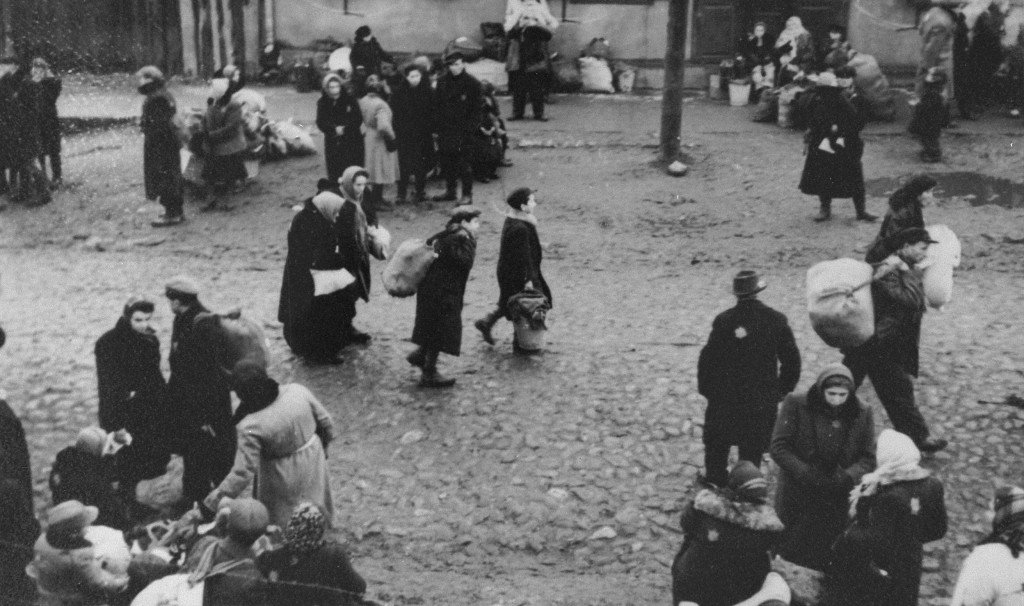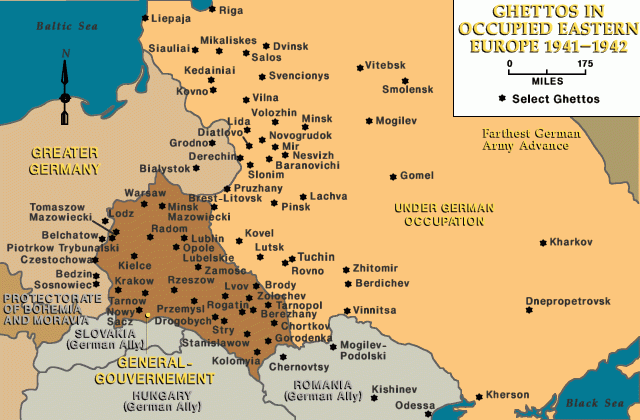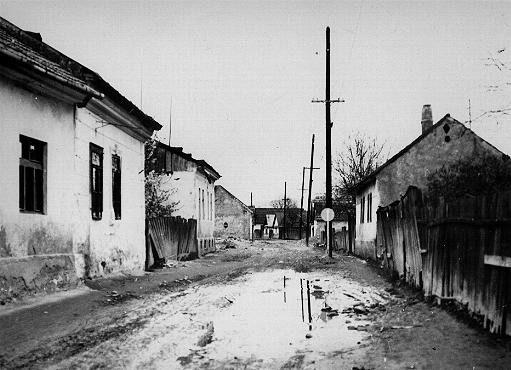
Ghettos
During the Holocaust, the creation of ghettos was a key step in the Nazi process of brutally separating, persecuting, and ultimately destroying Europe's Jews. Jews were forced to move into the ghettos, where living conditions were miserable. Ghettos were often enclosed districts that isolated Jews from the non-Jewish population and from other Jewish communities.
Key Facts
-
1
German occupation authorities established the first ghetto in Poland in Piotrków Trybunalski in October 1939.
-
2
The ghettos isolating Jews were meant to be temporary. In many places, ghettoization lasted only a few days or weeks. In others, ghettoization lasted for several years.
-
3
The vast majority of ghetto inhabitants died from disease, starvation, shooting, or deportation to killing centers.
Origin of the Term "Ghetto"
The term "ghetto" originated from the name of the Jewish quarter in Venice, Italy. Venetian authorities compelled the city's Jews to live in the quarter, which was established in 1516. In the 16th and 17th centuries, officials ranging from local authorities to the Austrian emperor ordered the creation of ghettos for Jews in Frankfurt, Rome, Prague, and other cities.
Ghettos during World War II

During World War II, the SS and other German occupation authorities concentrated urban and sometimes regional Jewish populations in ghettos. Living conditions were miserable. Ghettos were often enclosed districts that isolated Jews by separating Jewish communities from the non-Jewish population and from other Jewish communities. The Germans established at least 1,143 ghettos in the occupied eastern territories. There were three types of ghettos:
- closed ghettos
- open ghettos
- destruction ghettos
German occupation authorities established the first ghetto in occupied Poland in Piotrków Trybunalski in October 1939. The largest ghetto in occupied Poland was the Warsaw ghetto. In Warsaw, more than 400,000 Jews were crowded into an area of 1.3 square miles. Other major ghettos were established in the cities of Lodz, Krakow, Bialystok, Lvov, Lublin, Vilna, Kovno, Czestochowa, and Minsk. Tens of thousands of western European Jews were also deported to ghettos in the east.
The Germans ordered Jews in the ghettos to wear identifying badges or armbands. They also required many Jews to carry out forced labor for the German Reich. Nazi-appointed Jewish councils (Judenraete) administered daily life in the ghettos. A ghetto police force enforced the orders of the German authorities and the ordinances of the Jewish councils. This included facilitating deportations to killing centers. Jewish police officials, like Jewish council members, served at the whim of the German authorities. The Germans did not hesitate to kill those Jewish policemen who were perceived to have failed to carry out orders.
Ghettos and the "Final Solution"
In many places, ghettoization lasted a short time. Some ghettos existed for only a few days. Others lasted for months or years. The Germans saw the ghettos as a provisional measure to control and segregate Jews while the Nazi leadership in Berlin deliberated upon options for the removal of the Jewish population.
With the implementation of the "Final Solution" (the plan to murder all European Jews) beginning in late 1941, the Germans systematically destroyed the ghettos. The Germans and their auxiliaries either shot ghetto residents in mass graves located nearby or deported them. Jews were deported to killing centers. German SS and police authorities also deported a small minority of Jews from ghettos to forced-labor camps and concentration camps.
In August 1944, German SS and police completed the destruction of the last major ghetto, in Lodz.
Resistance in the Ghettos
Jews responded with a variety of resistance efforts. Ghetto residents frequently smuggled food, medicine, weapons, or intelligence across the ghetto walls. These and other such activities often took place without the knowledge or approval of the Jewish councils. On the other hand, some Jewish councils and some individual council members tolerated or encouraged the smuggling because the goods were necessary to keep ghetto residents alive.
The Germans generally showed little concern in principle about religious worship, attendance at cultural events, or participation in youth movements inside the ghetto walls. However, they often saw a “security threat” in any social gathering and would move ruthlessly to incarcerate or kill perceived ringleaders and participants. The Germans generally forbade any form of consistent schooling or education.
In the very beginning, my mother and several other women organized a clandestine school for children who were below the age of work, and it was a wonderful thing because we had something to look forward to
—Charlene Schiff
In some ghettos, members of Jewish resistance movements staged armed uprisings. The largest of these was the Warsaw ghetto uprising in spring 1943. There were also violent revolts in Vilna, Bialystok, Czestochowa, and several smaller ghettos.
Ghettos in Hungary
In Hungary, ghettoization did not begin until the spring of 1944 after the German invasion and occupation. In less than three months, the Hungarian gendarmerie, coordinating with German deportation experts from the Reich Main Office for Security, concentrated nearly 440,000 Jews from all over Hungary except for the capital city, Budapest. They forced the Jews into short-term “destruction ghettos” and then deported them into German custody at the Hungarian border. The Germans deported most of the Hungarian Jews to the Auschwitz-Birkenau killing center.

In Budapest, Hungarian authorities required Jews to confine themselves to marked houses (so-called Star of David houses). On October 15, 1944, leaders of the fascist Arrow Cross movement seized power in a German-sponsored coup. A few weeks later, the Arrow Cross government formally established a ghetto in Budapest. About 63,000 Jews lived in this 0.1 square mile area. Approximately 25,000 Jews who carried certificates indicating they were under the protection of a neutral power were confined in an "international ghetto" in the city. In January 1945, Soviet forces liberated that part of Budapest in which the two ghettos were located and liberated the nearly 90,000 Jewish residents.
Critical Thinking Questions
- Why did the Nazis resort to a system of ghettos?
- Besides armed resistance, in what other ways did the Jews resist the Nazis while forced to live in the ghettos?

